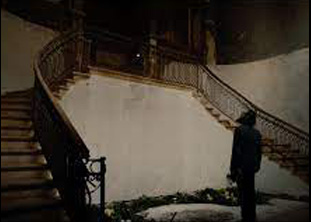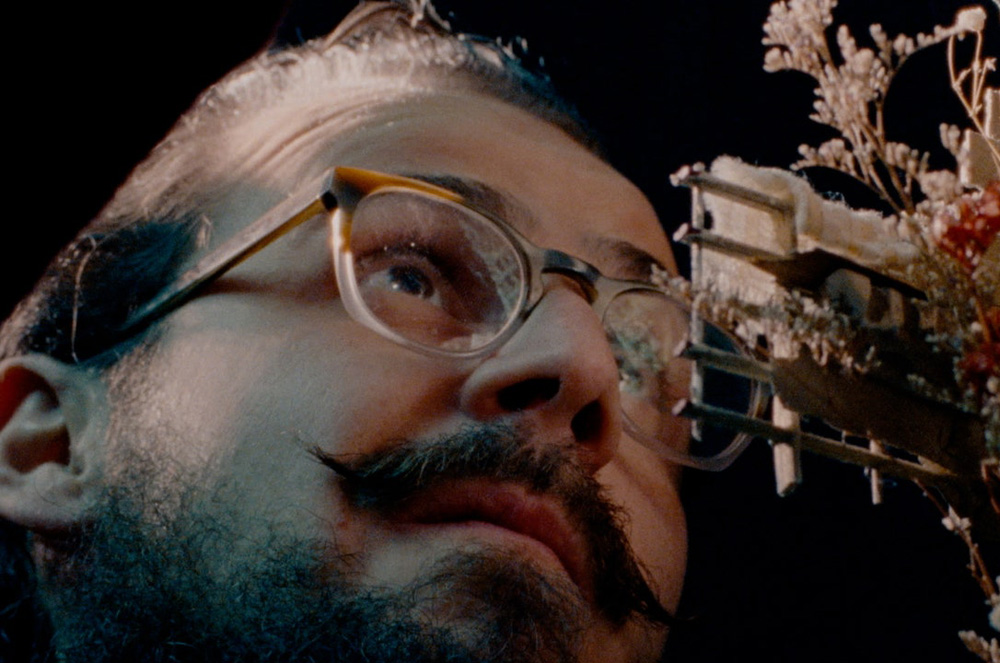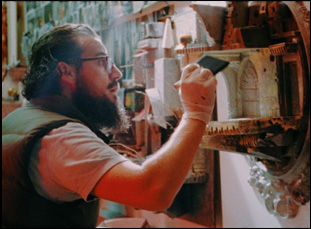Mohamad Hafez had come to America to study architecture in the early 2000s, unaware that when he was leaving his homeland of Syria, he wouldn’t be able to return as the travel ban that was imposed during 9/11 became one obstacle and then the civil war that erupted in the country in 2011 became another. His skill would lead to invitations to pitch on projects budgeted in the hundreds of millions of dollars all over the world, but the personal cost was considerably greater as he couldn’t be in the one place he’d most want to be, missing weddings and funerals for beloved family members and helplessly watching on television as cities such as Damascus had been leveled, wiping out centuries of civilization and all the history that was carried in its buildings reduced to rubble.
“A Broken House” finds Hafez in New Haven, Connecticut, able to still connect with his mother who continues to live in Syria over an iPad in his kitchen, yet will often go downstairs to get a greater sense of home. Rather than lament what was, he has taken it upon himself to build it back up one diorama at a time, using the household items available to him to recreate scenes from his youth and reconstruct Syria in order to return, if not by foot at least in his own mind. Celebrated by the art world, the dioramas have been able to bring a greater global consciousness as to all that’s been lost in the war, but director Jimmy Goldbum is on hand to see Hafez take steps towards seeing it for himself as the artist heads back to the Anfeh Refugee Camp in Lebanon to be closer to his mother around the holidays and comes to terms with seeing flat land where minarets once stood tall.
Like his subject, Goldblum sees considerably more than just what’s in front of him in “A Broken House,” when the short follows his previous feature “Tomorrow We Disappear,” about the displacement of the Kathputli Colony of artists in New Delhi and its reflection of how slippery a society’s cultural identity can be when it isn’t properly tended to. As Hafez valiantly salvages what he can from his own experience, “A Broken House” illustrates how art can sustain communities and why it is often targeted first by those trying to destroy them and following its online premiere on The New Yorker, it is making an appearance on the big screen this week as part of DOC NYC where the venue matches the size of Hafez’s ingenuity. On the eve of the festival, Goldblum spoke about how he was able to properly convey the liveliness of the artist’s work on screen, traveling back to the Middle East with him and the quite unexpected journey “A Broken House”’ took to reach audiences.
I was working on a TV show for Apple+ called “Home” that explores architects and the way they explore the theme of home in their work. Mohamad’s story actually surfaced as part of the research for the first season of that series and I was like, “Oh my God,” this is everything I want to tell.” My previous film “Tomorrow We Disappear” was all about cultural loss in India and I have a little bit of an obsession around it, so I really wanted to tell the story. Then an executive that actually works at Apple ended up rejecting it because Mohammad’s house wasn’t nice enough. [laughs] This was in 2017 and it was a small miracle that I happened to meet the former congressman Dick Gephardt [around the same time]. Trump had just announced his Muslim ban and Dick was apoplectic about the state of immigration in our country and the way immigrants and refugees were being spoken about, and he was looking to tell stories that were humanizing in a dehumanizing climate, so I called Mohammad and said, “Mohamad, if I can find a way to tell your story independently, would you still work with me?” And thankfully he agreed.
I’m jumping ahead, but cinematography is so striking in this and so clearly tied to the idea of architecture – how conscious were you in presenting Mohamad in the spaces he was in?
For me, it was really important to shoot this on film — we actually shot it on Super 16 and the reason for that was that when you stand in Mohamad’s studio and you see his art and his sculptures, the verisimilitude of the architecture that he recreates and also the destruction, I just wanted to get as close as possible in the filming to capturing that feeling of being there. His work is very tangible, it’s very dusty, and you can feel the texture, so I felt like an analog format would best reflect it. Some of that also is a testament to Oliver Millar, my cinematographer in Connecticut Oliver Millar and Zach Lowry, my cinematographer in Lebanon who are incredibly talented artists and [when] Mohamad’s an artist, I always wanted to approach it as a dialectic between our art and see what unfolds. The film certainly has an interesting desaturated quality and then we were shooting Mohamad in winter in Connecticut, so there’s this cloud, dreamlike sheen over the landscape and then the film format allows you to feel the particulate that maybe digital maybe shines over.
Then alongside that, I was really interested in immersing an audience in his work. He creates these lifelike representations of Damascan facades that have been destroyed, so a tool I relied on was an old periscope lens called a CineMagic Revolution that are traditionally used when you’d want to shoot a Hollywood model of a city and make it come to scale. We were really lucky to get one for this production and it has this very long lens that you can put right into the middle of the ark. All of a sudden, you feel like you’re living inside it and I wanted to break down the division between Mohammad’s art world and the world of Syria.

There was no plan for a trip to Lebanon, but that’s the beauty of the documentary process is you make a really beautiful plan and you have the resolve to abandon it. I was filming Mohammad in Connecticut and then he got on a Skype call with his mom and was like, “I’ll see you for New Year’s” and I was like, “What are you talking about?” And he’s like, “Well, I can’t go to Damascus because they would draft me into the army, so the closest I can be to my mother is in Beirut, which is only an hour away,” and I [said], “Hey, can we come?” I had read about Mohamad’s art — he had gotten a piece into the permanent collection at the Brooklyn Museum, and the New Yorker and the New York Times had written about him, so he’d been profiled, but his later work had not and I had no understanding of what was going on with his family.
And we in our media culture pay quite a lot of attention when it comes to two things regarding war — one is the death count and the economic toll, but we never talk about these other things that are lost in war, so the film was always for me a way to talk about the cultural and the architectural loss, but also the loss of the family system in that he had this super tight-knit family. The war had found a way to fracture them, so the Lebanon trip was really the way we were able to get at that layer.
Was there a shift in energy on the project when traveling with him between those two locations?
I almost feel like there’s a chapter/storybook quality to the film [where] there’s a part one and a part two and it got deeper and deeper, going to the refugee camp together, us spending time with his mother, and being back in the Middle East so close to home. When we weren’t filming, Mohammad was going to every architectural site he could in Lebanon, just sketching and breathing it in and maybe emotions that he was compartmentalizing in Connecticut started to surface. There is also just sometimes this ineffable magic that happens when you’re filming and I don’t know if you recall, but at the very last moment of the film, Mohamad has said goodbye to his mother — it’s the last thing that we filmed — and then he just went outside to let the feeling sink in, to just fully meditate on what he experienced in confronting her and then all of a sudden, a lightning storm happened. This was not in the weather [forecast]. I can’t be clear enough about that. It wasn’t like, “Okay, Mohamad, get out there, there’s a lightning storm.” He went out there and you can have the greatest plan in the world, but the best thing you could do is just be open to the magic that presents itself that’s out in front of you.
There is also this home video footage of his family, which you understand has to be super-rare when much of their family archives have been lost in the war. What was it like to get your hands on?
It was beautiful to receive the archival footage from Mohamad’s childhood and every single thing that we got added a layer because I wanted to make a movie that was about the ways in which we as a culture do not see Muslim immigrants or refugees, and this is a film about being seen. That’s what it means to me. The media creates this feeling that refugees have lived in tents their whole lives and their cities are nothing but rubble, so when you see those images, it’s easy to believe that immigrants or refugees come from nothing, and that’s the media soil on which a demagogue like Trump can thrive. So I saw the film as a corrective to that, really trying to honor just the incredible cultural history through Mohamad’s art and also honor the beauty of his family system, which got fractured by this war and what I wanted to get at at the end was [to be able] to see the art from a distance of the first time and then to fully understand all the things that went into it. The deepest thing for me is the family because when Mohamad says, “I miss home, I miss home,” what I think he’s actually saying is “I miss being in a place where I felt seen, where I felt safe and I felt connected.” And the archival is what I think elucidates that.
As you mentioned, “Tomorrow We Disappear” tackles equally large ideas yet you had the canvas of a feature there. Was it different adjusting to a shorter form?
“A Broken House” is actually my first short because I had never made anything before “Tomorrow We Disappear” — I just went straight to a feature because I think I’m crazy. [laughs] But what I began to realize in the process of making a short is that it’s sculptural in a way, taking as much out as possible to get at the strongest feeling. It’s like chipping away at marble to make a statue, and for me, a short is best when it’s just leaving you with a feeling. There’s not a prerequisite in a short to have a fully formed thesis. You just want to make people feel as much as possible and leave them in that ambiguity of feeling and that’s what I tried to do. I wanted to make something that felt complex and had many layers to it, but didn’t have easy answers, so in that sense, it was a really fun exercise.

We finished right before the pandemic and then it was just so hard because we thought we were in festivals and all the festivals were going virtual, so it was just a mess. Then somewhere in the middle of quarantine, the film just found its footing on the festival circuit and what was happening was Mohamad hadn’t been under the same roof as his family for 15 years — he had missed weddings, funerals, and his loved ones and all of a sudden as a global culture, we were all experiencing that very same thing. We were all beginning to feel the isolation, just a small fraction of what his reality has been, so as quarantine went on, I think the film got much deeper for people because they could see themselves in it.
We played our first film festival in front of a live audience at Palm Springs Shortsfest and I just cried so much. I had just missed being together in a theater and I remember at the Q & A, this 70-year-old man from Nigeria stood up in tears and he was just like, “This is my story. I haven’t been home in 40 years. Thank you for telling my story.” And I’m just so grateful that I’m in a space where I can talk to people and they can respond and connect to this movie finally. I’m so grateful we’re going to DOC NYC and we’re going to screen it in person because the theater is a holy, sacred space to me. We need each other and I think the film is touching on that — we need each other and it’s a really unfortunate thing when we’re forced apart.
“A Broken House” will screen at DOC NYC as part of Short List Block #1: Unjust Systems at the Cinepolis Chelsea on November 11th at 2 pm and November 18th at 2:30 pm. It is also available virtually through DOC NYC and at the New Yorker.





